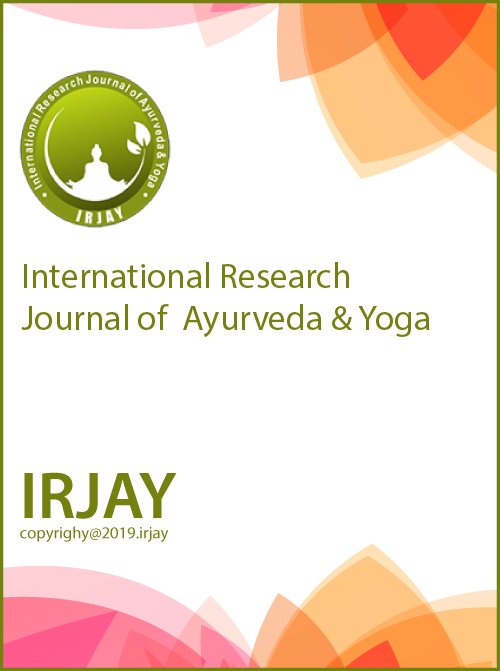Conceptual Study On Effects Of Amrita Guggulu in the management of Amavata
DOI:
https://doi.org/10.48165/Keywords:
Amrita Guggulu, Amavata, Rheumatoid arthritisAbstract
Ayurveda is one of the oldest system of healthcare in the world. In Ayurveda,‘Amavata’ was mentioned for the first time by AcharyaMadhavakara as a special disease entity in which both‘Ama’as well as ‘Vata’play a predominant role in the pathogenesis of this disease.‘Amavata’ is one of the crippling diseases causingthe maximum loss of human power.It is not only a joint disorder but is also a systemic disease and is named after it’s chief pathogenic constituent which are ‘Ama’ and ‘Vata’.The disease ‘Amavata’ is very similar to Rheumatoid Arthritis. It is chronic in nature and effect mostly the middle age group. Theonset of Rheumatoid arthritis is most frequent during the fourth and fifth decades of life, with 80% of all patients developing the disease between the age of 35 and 50. The incidence of RA is more than six times as great in 60-to-64-year-old women compared to18- to29-year-old women. Soneed of time is to go for cost effective, safe and efficient treatment of Amavata.Although, there are many drugs available in modern medical science for the treatment of Rheumatoid arthritis (Amavata) but they are associated with adverse effects, so there is need of the hour to look into the safe herbal remedy which not only treat the disease but also helps in reducing the relapse of the disease.Keeping all above points in mind theAmrita Gugguluhas beenselected to know the effect in treating Amavata (Rheumatoid arthritis).Amrita Gugguluconsists of6 main contents which have different properties it consist of Guduchi, Shuddha Guggulu ,Haritaki, Vibhitaka, Aamalaki and Prakshepa Dravya Danti, Shunthi, Pippali, Maricha, Vidanga ,Guduchi, Haritaki,Vibhitaka, Aamalaki, Twaka, Trivrit.
Downloads
References
iHarrison T.R. et al;17th Ed. Harrison's principles of Internal Medicine; Vol. I and II, 17th International edition, 2007; published by McGraw-Hill Book o. Singapore
iiAlagappan of Clinical medicine chapter connective tissue disorder pg no 347
iii. पुराणस्त्िितलेखनोः (सु.सु.२५ )
ivManjrekar PN, Jolly CI, Narayanan S. Comparative studies of the immunomodulatory activity of Tinosporacordifolia and Tinosporasinensis. Fitoterapia2000;71:254-7.
vDikshit V, Damre AS, Kulkarni KR, Gokhale A, Saraf MN. Preliminary screening of imunocin for immunomodulatory activity. Indian J Pharm Sci 2000;62:257.
viDahanukar SA, Thatte UM, Pai N, More PB, Karandikar SM, et al. Immunotherapeutic modification by Tinosporacordifolia of abdominal sepsis induced by caecal ligation in rats. Indian J Gastroenterol 1988;7:21-3. viiSinha, K., Mishr, NP., Singh, J. &Khanuja, SPS., 2004.Tinospora cordifolia, a reservoir plant for therapeutic application.Ind. J. of traitional. knowledge, 3(3): pp. 257-270.
viii.Su S, WangT etal, Anti-inflammatory and analgesic activity of different extracts of Commiphora mukul. J Ethnopharmacol. 2011 Mar 24;134(2):251-8
ix.Su S, Hua Y et al, Evaluation of the anti-inflammatory and analgesic properties of individual and combined extracts fromCommiphora myrrha, and Boswellia carterii. J Ethnopharmacol. 2012 Jan 31;139(2):649-56.
xDodke P. C, Pansare T. A. Ayurvedic and Modern aspect of Terminalia chebula Retz. Haritaki An Overview International Journal of Ayurvedic and Herbal Medicine 7:2(2017) 2508–2517 xiOgura M, Koike K, Cordell GA, Farnsworth NR. Potential anticancer agents VIII. Constituents of Baliospermummontanum (Euphorbiaceae). Planta Medica1978;33:128-4
xiiAsano Y, Tamura K, Doi N, Ueatrongchit T, H-Kitt ikun A, Ohmiya T. Screening for new hydroxynitrilases from plants. Bioscience Biotech Biochem2005;69:2349-57.
xiiiMali RG, Mahajan SG, Mehta AA. Antimicrobial activity of BaliospermummontanumMuell-Arg leaves. Planta Indica 2006;2:13-4.
xiv John A.O Ojewole, Analgesic, antiinflammatory and hypoglycaemic effects of ethanol extract of Zingiberofficinale (roscoe) rhizomes (zingiberaceae) in mice and rats,Phytotherapy Research 2006 Sep;20(9):764-72.
xvAimbire F, et. Al Effect of hydroalcoholic extract of Zingiber officinalis rhizomes on LPS-induced rat airway hyperreactivity and lung inflammation, Pubmed2007 oct 6;77(3-4) :129-38.
xviUtpalendu Jana, Chattopadhyaya RN, Badri Prasad Shaw, Preliminary studies on anti- inflammatory activity of ZingiberofficinaleRosc. , Miers in albino rats ; Indian Journal of Pharmacology ; 2006; 38:1, Pg No. 58-59.
xvii Garg N, Jain Akhil Ayurvedic Drugs Used In Eye Disorders, Published by Educreation New Delhi 2017; Page No.46
xviiiSunila E.S. &Kuttan G. Immunomodulatory and antitumor activity of Piper longum Linn. and piperine. J Ethnopharmacol 2004., 90(2-3): 339-346
xixGulcin et al. The antioxidant and radical scavenging activities of black pepper(Piper nigrum) seeds. Int J Food and Sci Nutrition2005 Nov;56(7):491-9
xxUma Bandari and M Nazam Ansari: Antihyperglycaemic activity of aqueous extract of Embelia ribes Burmin streptozotocin-induced diabetic rats. Indian J Exp Biol 2008: 46: 607-620
xxiSamuel O. Onoja. Investigation of the Laxative Activity of OperculinaturpethumExtract in Mice, International Journal of Pharmaceutical and Clinical Research 2015; 7(4): 275-279
xxiiWho.int [internet]. Geneva: World Health Organisation; c 2016 [updated 2016; cited 2016 May 11]. Available from: http://www.who.int/chp/topics/ rheumatic/en/.
xxiiiMalaviya AN, Kapoor SK, Singh RR, Kumar A, Pande I. Prevalence of rheumatoidarthritis in the adult Indian
population. Rheumatol Int 1993;13(4): 131e4.xxivLipsky Peter E. Rheumatoid arthritis. In: Longo DL, Kasper DL, Jameson JL, Fauci AS, Hauser SL, Loscalzo J,
editors. Harrison principles of internal medicine. 18th ed., vol. II. New York: Mc Graw Hill; 2012. p. 2738e52.

